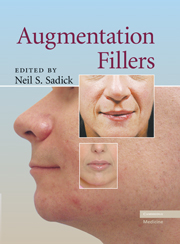Book contents
- Frontmatter
- Contents
- LIST OF CONTRIBUTORS
- Ch. 1 Application of Fillers
- Ch. 2 Approach to Choosing the Ideal Filler
- Ch. 3 Patient Selection, Counseling, and Informed Consent
- Ch. 4 Hyaluronic Acid Skin Derivatives
- Ch. 5 Collagen Products
- Ch. 6 Radiesse
- Ch. 7 ArteFill
- Ch. 8 Augmentation Fillers in Cosmetic Dermatology: Silicone
- Ch. 9 Advanta Expanded Polytetrafluoroethylene Implants
- Ch. 10 Sculptra
- Ch. 11 Lipo Transfer
- Ch. 12 BioAlcamid®
- Ch. 13 Combination of Approaches in Augmentation Fillers in Cosmetic Dermatology
- Ch. 14 Filling Complications
- Ch. 15 Postprocedure Management and Patient Instructions
- Ch. 16 Conclusion: Future Trends in Fillers
- INDEX
- References
Ch. 15 - Postprocedure Management and Patient Instructions
Published online by Cambridge University Press: 26 February 2010
- Frontmatter
- Contents
- LIST OF CONTRIBUTORS
- Ch. 1 Application of Fillers
- Ch. 2 Approach to Choosing the Ideal Filler
- Ch. 3 Patient Selection, Counseling, and Informed Consent
- Ch. 4 Hyaluronic Acid Skin Derivatives
- Ch. 5 Collagen Products
- Ch. 6 Radiesse
- Ch. 7 ArteFill
- Ch. 8 Augmentation Fillers in Cosmetic Dermatology: Silicone
- Ch. 9 Advanta Expanded Polytetrafluoroethylene Implants
- Ch. 10 Sculptra
- Ch. 11 Lipo Transfer
- Ch. 12 BioAlcamid®
- Ch. 13 Combination of Approaches in Augmentation Fillers in Cosmetic Dermatology
- Ch. 14 Filling Complications
- Ch. 15 Postprocedure Management and Patient Instructions
- Ch. 16 Conclusion: Future Trends in Fillers
- INDEX
- References
Summary
INTRODUCTION
With the unprecedented rise in the use of injectable fillers, an increasing number of patients are approaching their physicians to undergo soft tissue augmentation. It is absolutely essential to educate patients about the procedure, its potential benefits, and its potential complications. As always, this should be done prior to the procedure to be most effective. Detailed pre- and postprocedure instructions are an essential part of this education process. It is this education that ultimately empowers patients and helps them to achieve their ideal cosmetic outcome.
Effectively written pre- and postprocedure instructions serve multiple important functions in educating patients regarding their cosmetic procedures. First and foremost, the instructions help patients to understand what to expect from the procedure. Second, they educate patients regarding potential adverse events and possible complications from procedures. Third, they educate patients regarding potential medications and activities that may compromise the postprocedure period or even the cosmetic outcome of the procedure. Finally, they allow the physician to instruct the patient in the management of simple and common postprocedure issues and events that may occur.
In order for these instructions to be of the most benefit, it is essential that they be written in layman's terms. Instructions with complex medical terminology will only serve to confuse the patient, increase their anxiety regarding the procedure, and decrease their likelihood of achieving their desired outcome. The instructions should always be reviewed prior to the procedure with the patient.
- Type
- Chapter
- Information
- Augmentation Fillers , pp. 137 - 148Publisher: Cambridge University PressPrint publication year: 2010



